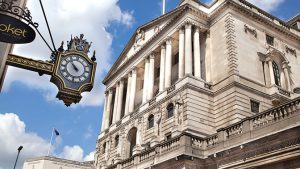Bloomberg
Like they did after the 2008 crash, the UK’s two economic policy heavyweights are playing good cop-bad cop. It’s just that this time they’ve swapped roles.
In the years following the financial crisis, the Bank of England (BOE) stuck resolutely to easy money while fiscal policy got tough when Chancellor of Exchequer George Osborne imposed swingeing budget cuts.
But as the economy grapples with the highest inflation level in three decades and the fallout from the war in Ukraine, it’s BOE Governor Andrew Bailey who’s playing the bogeyman. The central bank, which is expected to hike interest rates for a third straight meeting, is taking the lead among global peers with a high-speed tightening of monetary policy,
By contrast, Treasury chief Rishi Sunak — for all his talk of the need to rein in borrowing — is keeping more of his pandemic fiscal stimulus in place than most other developed countries and spending billions more to shield households from a surge in the cost of everyday goods and services.
Tellingly, as the conflict in Ukraine rages, it’s also the Chancellor, not the BOE, who is facing increasing calls to step in to support economy further.
The switch among the policy heavyweights may come into sharper focus this month, when the BOE’s rate decision is set to be followed within days by Sunak’s spring statement, a fiscal update akin to a mini-budget.
The turnaround is part of a the wider re-evaluation of how fiscal and monetary policies can best work to support economies, in the UK and
beyond.
The UK was one of the biggest Covid spenders. Its budget stimulus was matched only by the US, relative to the size of their economies, according to UBS. Sunak’s measures to prop up incomes for workers and businesses cost a total of about 370 billion pounds ($484 billion), including loans.
The BOE offered full support, slashing interest rates to near-zero and buying government debt to soak up the extra borrowing. The 440 billion pounds of BOE bond buying between March 2020 and December 2021 was enough to offset about 94% of the increase in the UK’s net borrowing requirement over the period.
In the years after 2008, when the economy was slow to recover, the government soon pivoted to arguing that the top priority was to lower budget deficits and debt.
Osborne used the specter of bond-market turmoil and debt crises in euro-area countries like Greece or Spain to invoke the need for fiscal austerity. And he pointed to the low interest rates on British government debt as evidence that his plan was working.
 The Gulf Time Newspaper One of the finest business newspapers in the UAE brought to you by our professional writers and editors.
The Gulf Time Newspaper One of the finest business newspapers in the UAE brought to you by our professional writers and editors.
